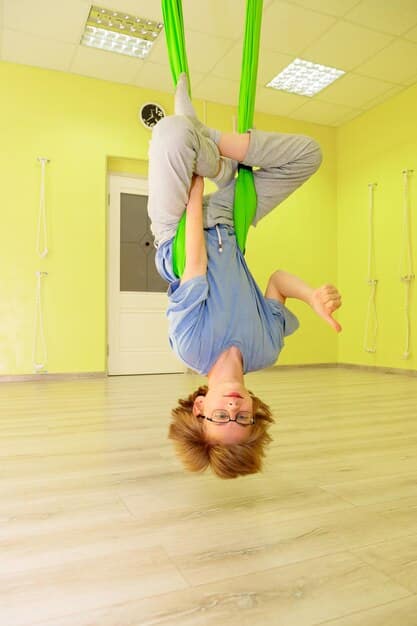Sensory Integration Activities: Support for Children’s Development

Practical sensory integration activities offer vital support for children facing sensory processing challenges, enabling them to better navigate and interact with their environment by organizing sensory input effectively.
Navigating the complex world can be particularly challenging for children with sensory processing difficulties. Understanding and implementing effective sensory integration activities can transform their daily experiences, fostering better regulation and engagement. These strategies are not just about play; they are crucial therapeutic tools designed to help children make sense of the sensory information they receive, promoting healthy development and interaction with their surroundings.
Understanding sensory processing challenges
Before diving into specific activities, it’s essential to grasp the fundamentals of sensory processing and what constitutes a challenge. Sensory processing refers to the way our nervous system receives, organizes, and responds to sensory input from the environment and from our own bodies. For most individuals, this process happens seamlessly, allowing us to interpret information and react appropriately. However, for some children, this system doesn’t function as smoothly, leading to what is known as Sensory Processing Disorder (SPD).
Children with SPD might be hypersensitive (over-responsive) or hyposensitive (under-responsive) to certain sensory inputs, or they might struggle with sensory discrimination or modulation. This can manifest in various ways, from extreme reactions to loud noises or certain textures, to a constant need for movement or difficulty understanding where their body is in space. These challenges are not behavioral issues; rather, they stem from neurological differences that impact how the brain processes sensory information.
Recognizing the signs of SPD
Identifying sensory processing challenges early is crucial for providing timely and effective support. Parents and caregivers might observe a range of behaviors that indicate a child is struggling. These signs can vary widely depending on the type and severity of the sensory processing difficulty.
- "Picky" eating habits that go beyond typical preferences, often related to food texture or smell.
- Over-reaction to sounds, lights, or touch, such as covering ears, squinting eyes, or avoiding hugs.
- Under-reaction to pain or temperature, seemingly oblivious to injuries or extreme temperatures.
- Difficulty with fine or gross motor skills, appearing clumsy or struggling with tasks like buttoning shirts.
Observing these patterns can help prompt a conversation with a pediatrician or an occupational therapist specializing in sensory integration. An accurate assessment is the first step toward developing a tailored intervention plan that includes appropriate sensory integration activities tailored to the individual child’s needs.
Understanding these challenges is the cornerstone of effective intervention. It allows caregivers to approach difficulties with empathy and an evidence-based perspective, moving beyond simply managing "bad behavior" to genuinely supporting the child’s neurological development. This foundational understanding empowers parents and educators to create environments that are both nurturing and therapeutically beneficial.
The role of sensory integration therapy
Sensory integration therapy, often delivered by occupational therapists, is a specialized form of intervention designed to help children with SPD improve their ability to process and organize sensory information. This therapy is rooted in the work of Dr. A. Jean Ayres, who developed the theory of sensory integration. Her research highlighted how difficulties in processing sensory input could significantly impact a child’s learning, behavior, and social participation.
The core principle of sensory integration therapy is to provide controlled sensory experiences that challenge the child in a playful and engaging manner. The therapist guides the child through activities specifically chosen to address their unique sensory needs, encouraging them to actively participate and adapt their responses. This active engagement helps the child’s brain to form new, more efficient neural pathways, leading to improved sensory processing.
Key components of effective therapy
Effective sensory integration therapy goes beyond simply exposing a child to sensory stimuli. It involves a carefully planned and individualized approach that considers the child’s specific sensory profiles and developmental goals. The therapist plays a crucial role in adapting activities and providing just the right amount of challenge to facilitate progress.
- Child-directed play: While structured, the activities are presented in a playful manner that encourages the child’s intrinsic motivation to explore and engage.
- Adaptive responses: The goal is not just to experience sensation but to help the child produce appropriate and effective responses to sensory input, improving their ability to organize and act on information.
- Therapist guidance: The occupational therapist continuously observes and adjusts the activities based on the child’s reactions, ensuring they are challenged without being overwhelmed.
The therapy often takes place in a "sensory gym" equipped with various tools such as swings, crash pads, ball pits, and climbing structures. These tools provide opportunities for vestibular (movement), proprioceptive (body awareness), and tactile (touch) input, which are often central to sensory integration. Through repetitive and purposeful engagement in these activities, children gradually enhance their capacity to process sensory information more efficiently, leading to positive changes in their overall functioning and participation in daily life.
Proprioceptive activities: enhancing body awareness
Proprioception is our sense of body position, movement, and force. It tells us where our body parts are in relation to each other and how much effort to use for a particular task. Children with proprioceptive challenges might appear clumsy, struggle with motor coordination, or seek out deep pressure and heavy work activities. Incorporating proprioceptive activities into their routine can significantly enhance their body awareness and motor control.
These activities involve resistance and deep pressure, which help activate the proprioceptors located in our muscles and joints. When these receptors are properly stimulated, they send clear signals to the brain, helping the child to better understand their body’s position and movements. This improved proprioceptive feedback can lead to better coordination, balance, and a greater sense of calm and organization.
Examples of proprioceptive activities
Many common play activities naturally provide rich proprioceptive input. Integrating these into a child’s daily schedule can be simple and enjoyable, offering therapeutic benefits without feeling like work.
- "Heavy work" activities: Pushing a wagon, carrying heavy books, helping with chores like vacuuming or moving furniture.
- Jumping and crashing: Jumping on a trampoline, crashing into a foam pit or a pile of pillows.
- Deep pressure: Bear hugs, wearing weighted vests (under professional guidance), or rolling up tightly in a blanket like a "burrito."
Beyond these, activities like climbing, crawling through tunnels, or even playing with playdough or thick clay can provide excellent proprioceptive input. The key is to find activities that the child enjoys and that can be easily incorporated into their routine, ensuring consistent and beneficial sensory input. These activities are particularly helpful for children who are constantly seeking movement or who struggle with motor planning and coordination, providing a constructive outlet for their sensory needs.

Vestibular activities: fostering balance and movement control
The vestibular system, located in the inner ear, is responsible for our sense of balance, spatial orientation, and movement. It tells us whether we are moving, how fast, and in what direction. Children with vestibular challenges might struggle with balance, appear fearful of movement, or, conversely, constantly seek intense spinning or swinging sensations. Vestibular activities are designed to stimulate this system in a controlled manner, helping children to better process movement information.
By engaging in activities that involve head movements, changes in body position, and varied speeds, children can gradually improve their vestibular processing. This leads to better balance, coordination, spatial awareness, and even improved attention and focus. The goal is to help the child’s brain accurately interpret and respond to vestibular input, reducing hypersensitivity or hyposensitivity to movement.
Engaging in movement-based play
Many popular playground activities naturally provide excellent vestibular input. Incorporating these into a child’s play routine can be incredibly beneficial and fun.
- Swinging: Traditional swings, platform swings, or tire swings. Varying the speed and direction can provide different types of input.
- Spinning: Spinning in circles, using a spin board, or engaging in gentle log rolls. Always supervise spinning carefully to avoid overstimulation.
- Sliding and rocking: Sliding down slides, rocking on a rocking horse, or using a therapy ball to gently rock back and forth.
Other activities like dancing, playing "Simon Says" with actions, or even just tumbling on a mat can provide valuable vestibular input. It’s important to observe the child’s reactions and ensure they are comfortable and engaged, stopping if they show signs of distress or overstimulation. Consistency with these activities can significantly improve the child’s ability to regulate their arousal levels and engage more effectively with their environment, making them feel more secure and grounded in their own bodies.
Tactile activities: exploring touch and texture
The tactile system processes information received through touch, including pressure, temperature, pain, and texture. Children with tactile processing challenges may be over-responsive to touch, leading to aversions to certain clothing, foods, or being touched by others. Conversely, they might be under-responsive, seeking strong tactile input or having difficulty noticing when they are touched. Tactile activities aim to help children regulate their responses to touch and develop better tactile discrimination.
By providing varied and rich tactile experiences, children can gradually desensitize to textures they once found overwhelming or become more aware of subtle tactile sensations they previously missed. These activities help the brain to properly register, interpret, and organize touch information, which is fundamental for daily tasks like dressing, eating, and interacting with the world.
Hands-on tactile experiences
Many everyday materials can be transformed into engaging tactile activities, promoting exploration and sensory regulation. These activities can be messy, but the benefits often outweigh the cleanup.
- Sensory bins: Bins filled with rice, beans, pasta, water beads, sand, or oats, with small toys hidden inside.
- Textured play: Playing with playdough, slime, kinetic sand, finger paints, or shaving cream.
- Brushing and massage: Using a soft brush (like a surgical brush, under professional guidance) for therapeutic brushing, or gentle massage with different textured rollers or balls.
Activities involving water play, feeling different fabrics, or even walking barefoot on various surfaces (grass, carpet, sand) can also provide beneficial tactile input. The goal is to introduce textures gradually and in a playful, non-threatening way, allowing the child to lead the exploration and indicating when they have had enough. Over time, consistent positive tactile experiences can significantly improve a child’s comfort with touch and their ability to discriminate different sensations, leading to greater participation in daily routines and social interactions.

Integrating sensory activities into daily routines
The true power of sensory integration activities lies in their consistent and purposeful integration into a child’s daily life. While therapy sessions are invaluable, they are complemented by ongoing sensory diets that parents and caregivers can implement at home and in school environments. A sensory diet is a personalized schedule of sensory activities designed to provide the specific types of input a child needs throughout the day to stay regulated, focused, and engaged.
Creating an effective sensory diet requires collaboration with an occupational therapist. The therapist assesses the child’s unique sensory needs and advises on which activities to incorporate and how often. The goal is to proactively meet the child’s sensory needs, thereby preventing meltdowns or avoidance behaviors that often arise when sensory systems are dysregulated.
Practical tips for implementation
Integrating sensory strategies doesn’t have to be complicated or require extensive resources. Many activities can be woven seamlessly into existing routines.
- Morning routine boosts: Start the day with heavy work like carrying laundry baskets or a quick jump on a small trampoline.
- School-time supports: Use fidget toys, allow movement breaks, or provide a weighted lap pad during desk work.
- Bedtime wind-down: Deep pressure activities like a tight roll in a blanket or a warm bath can help calm the nervous system for sleep.
Beyond structured activities, consider modifying the home environment to be more sensory-friendly. This might involve dimming lights, reducing background noise, or providing a quiet "sensory corner" where the child can retreat when feeling overwhelmed. Consistency, flexibility, and a playful approach are key to successful integration, making sensory activities a natural and enjoyable part of the child’s developmental journey. This holistic approach supports the child not just in specific therapeutic settings but throughout their entire day, nurturing their ability to thrive.
| Key Sensory Focus | Benefit for Children |
|---|---|
| 💪 Proprioception | Enhances body awareness, motor control, and regulation through deep pressure and heavy work. |
| 🤸 Vestibular | Improves balance, spatial orientation, and movement coordination via activities involving motion. |
| ✋ Tactile | Helps regulate touch responses and improves discrimination through varied texture exploration. |
| 🧘 Holistic Integration | Supports overall self-regulation, attention, and participation in daily life with consistent input. |
Frequently asked questions about sensory integration activities
Sensory integration is the neurological process of organizing sensations from one’s own body and from the environment, enabling effective use of the body within the environment. It’s crucial for children as it forms the foundation for learning, behavior, and social participation, helping them interpret and respond to sensory input.
Signs can vary, but may include extreme reactions to sounds/textures, appearing clumsy, difficulty with fine motor skills, or a constant need for movement. Persistent challenges in daily activities due to sensory input suggest a need for professional assessment by an occupational therapist.
Sensory integration activities are a key component often utilized within occupational therapy sessions, particularly for children with Sensory Processing Disorder. While occupational therapy encompasses a broader range of interventions, sensory integration is a specialized framework within it.
Absolutely! Many simple, fun sensory activities can be done at home using everyday items. However, for a structured "sensory diet" tailored to your child’s specific needs, it’s highly recommended to consult with an occupational therapist. They can provide personalized guidance and ensure safety.
If your child’s sensory challenges significantly interfere with their daily functioning, learning, social interactions, or overall well-being, it’s advisable to seek an evaluation from a pediatrician who can refer you to an occupational therapist specializing in sensory integration.
Conclusion
Supporting children with sensory processing challenges requires a blend of professional guidance, understanding, and consistent implementation of effective strategies. Sensory integration activities, when tailored to individual needs, empower children to better organize and respond to sensory input, leading to improved regulation, motor skills, and social engagement. By incorporating these practical strategies into daily routines, families can create nurturing environments that foster growth and help children thrive, building a stronger foundation for their overall development and well-being.





